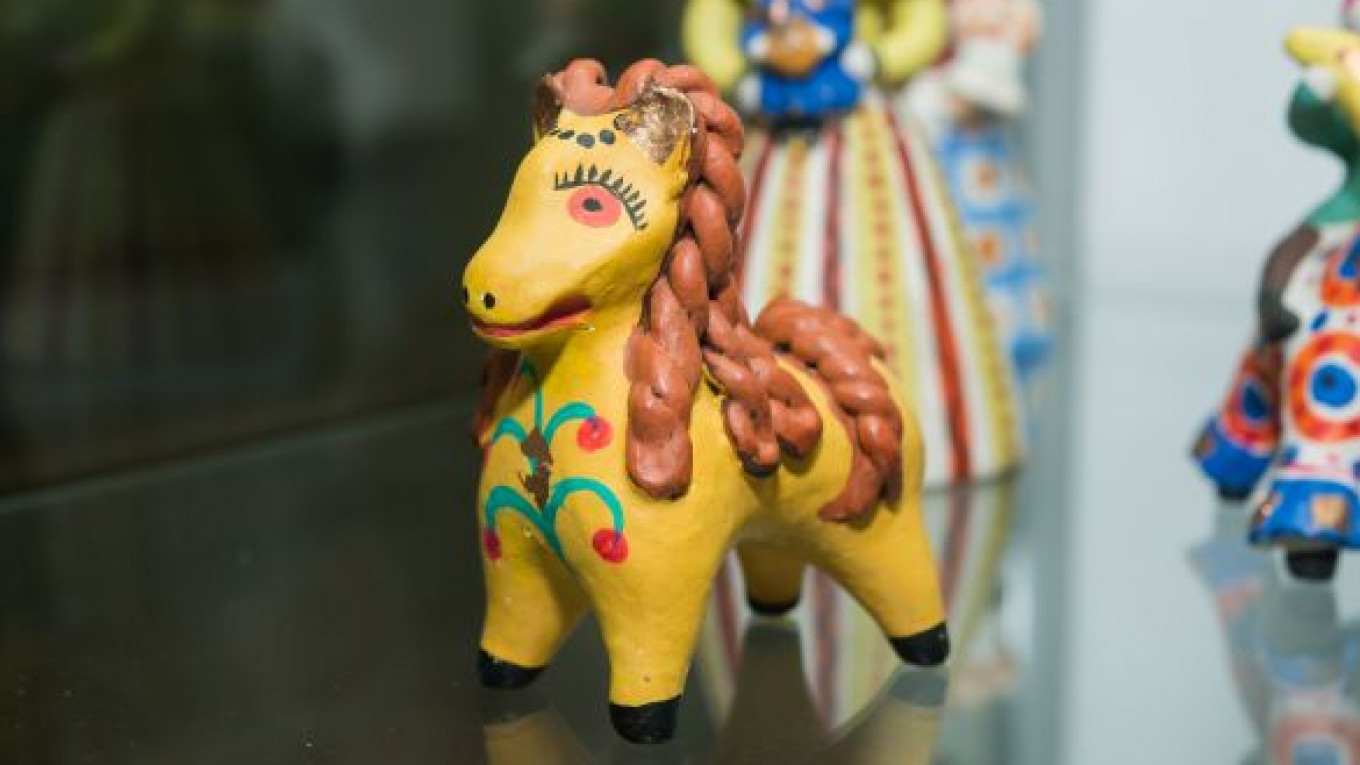Dymkov toys, old and new, have temporarily taken up residency in the All-Russian Museum of Applied and Folk Art. "Haze" is a bright showcase of varied, yet uniformly larger-than-life figurines, whose characters are anything but hazy.
The collection, comprised of artifacts from the past 160 years of the renowned Russian craft, includes photographs, reliefs, drawings and, of course, a vast array of the famous toys themselves.
The exhibition teaches visitors the basic features of this long-standing folk tradition, and manages to do so without taking itself too seriously, incorporating an all-important element of fun.
Even its name, "Haze" is a pun: Dymka, the Russian word for Haze, echoes the name of the town Dymkovo, after which the traditional figures are named.
According to exhibit curator Tamara Sakharova, the significance of the toys is not restricted to their resonance in folk art.
More generally, the toys can be seen as a depiction of the Russian people, culture and spirit, which is precisely why humor is such a crucial ingredient.
"Each artist has his or her own 'hand-print': The style of sculpture, motifs..."
Tamara Sakharova
Curator
"The Dymkovo toy is bright, festive, and always has a good sense of humor. It's a reflection of the Russian soul. That's why it's still so recognized, enjoyed and loved today," Sakharova said.
While the toys are perhaps best known as kitschy souvenirs, beloved by modern-day tourists to Russia, this is certainly not where the colorful folk tradition originated.
The exhibition maps the history of the craft and demonstrates its continued development over the years, thanks to technological advancements that have aided the production processes, such as better paints, brushes and clay furnaces.
The development of Dymkov toys is mapped out for viewers in detailed written descriptions accompanying the exhibits. However, basic but fascinating differences are easily noticeable: The more modern figurines are much more colorful and intricately decorated than their antique counterparts.
Acknowledging their role as decorative ornaments and trinkets, Sakharova seemed keen not to lose sight of their primary function as toys, stating that the exhibition's main objective was to be "especially close and understandable to children."
A wide selection of characters and situations are portrayed through the toys, giving visitors the impression that they are flipping through the bright pages of a picture book in which the toys are constantly interacting during weddings, dances or even a simple gathering around a samovar.
However, it's not all tea-sipping realism. The vivid colors and patterns, combined with exaggerated and grotesque depictions of well-known animals, such as two-headed horses, seem to lend a fairy-tale atmosphere to the scenes. This fusion of tradition and novelty excites the imagination of both adults and toddlers alike.
Minuscule details serve to enhance this effect.
"Each toy is made by hand, so the artist puts a piece of his or her soul into every one. On top of this, each artist has his or her own 'handprint': the style of sculpture, particular favorite topics, motifs, and a way of painting, … a personal flavor," Sakharova explained.
Although this "personal flavor"? that each of the toys possesses cannot be denied, the implication seems to be that perhaps the humans are actually not so different from the weird and wonderful circus of creatures jostling for the attentions of visitors after all.
The figures appeal to viewers of all ages precisely because they emulate children's play, acknowledging recognizable parts of life and adding a touch of escapism, blending the more believable and the outright far-fetched.
This is a craft that began as far more than a souvenir trade and has continued to develop over time, showing that Dymkov toys are much more than just child's play.
Contact the author at artsreporter@imedia.ru
A Message from The Moscow Times:
Dear readers,
We are facing unprecedented challenges. Russia's Prosecutor General's Office has designated The Moscow Times as an "undesirable" organization, criminalizing our work and putting our staff at risk of prosecution. This follows our earlier unjust labeling as a "foreign agent."
These actions are direct attempts to silence independent journalism in Russia. The authorities claim our work "discredits the decisions of the Russian leadership." We see things differently: we strive to provide accurate, unbiased reporting on Russia.
We, the journalists of The Moscow Times, refuse to be silenced. But to continue our work, we need your help.
Your support, no matter how small, makes a world of difference. If you can, please support us monthly starting from just $2. It's quick to set up, and every contribution makes a significant impact.
By supporting The Moscow Times, you're defending open, independent journalism in the face of repression. Thank you for standing with us.
Remind me later.


